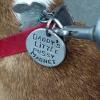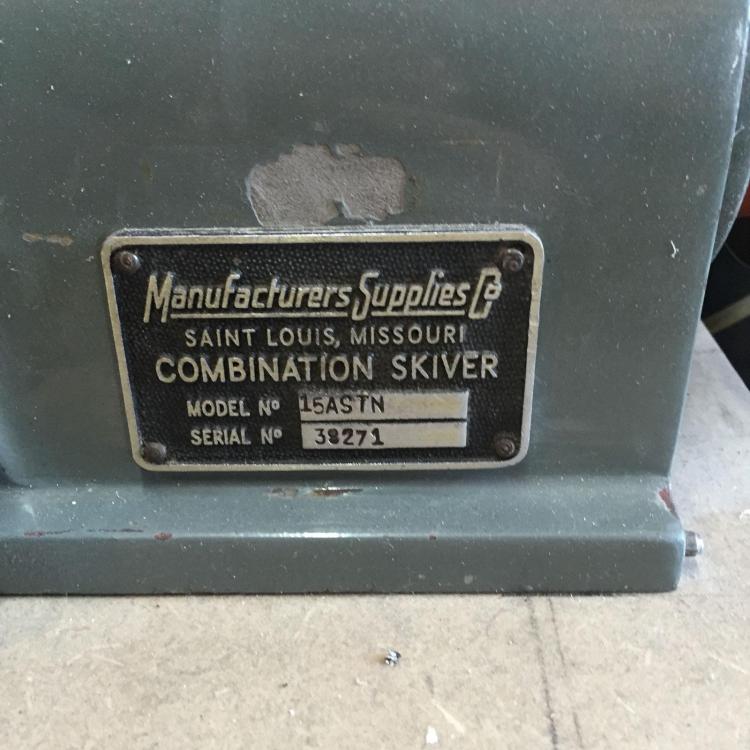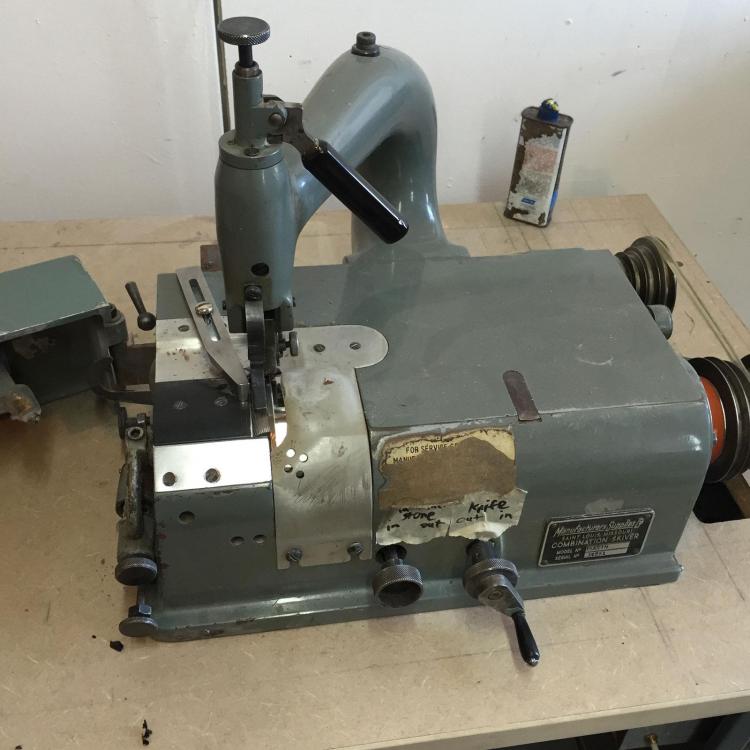-
Posts
428 -
Joined
-
Last visited
Content Type
Profiles
Forums
Events
Blogs
Gallery
Everything posted by Nuttish
-
If using a walking foot machine it's done with an open sided zipper foot. The distance between the needle and edge of the center foot determines the minimum distance between the edge of the magnet and stitch line. If you're using a foot that's open on the right side, you'd rotate your work clockwise. Left side counter clockwise. You can use double sided leather bonding tape on the interior to secure your magnet and a little pocket around it but be aware that very tacky glue or adhesive can affect the quality of your stitch.
-
The hook holds a spring attached to the bottom of the feed roll pivot. It allows you to adjust spring tension based on the thickness/stiffness of your material. The manuals describe how to do this. This particular machine has two additional adjustments on the feed roll mechanism that more or less match your description of knob/rod/spring, but they perform other functions than the purely vertical pressure adjustment the hook/spring controls. The one in the rear near the hook works in conjunction with it by setting the vertical upper limit of the feed roll mechanism's movement. You can also use it with an emery feed roll to lightly dress the inside edge of the knife as described in the Fortuna manual. I don't think it also has a spring, but it's a knob/rod. The other toward the front does have a spring and controls forward/rear tilt of the feed roll. The machine won't work without the spring attached to the hook - the feed roll mechanism will just fall to the bottom of its range of motion, which may hit the knife. As someone else said, the bolt on the top is probably for a lamp. Not sure what "small pin" you're referring to. If it's the dark line just to the left of the presser foot adjustments, that's just a wide joint between sheets of drywall. The previous tenant in my workshop space didn't do a great job building it out.
-
If you've got a premade table you won't have any trouble finding a cheap purpose-made V belt.
-
My machine is identical to yours, so I assume it was also made in West Germany. It doesn't appear to have ever had that badge, just a square one with a model number and no country of origin. Otherwise the same. I wouldn't bother reaching out to Manufacturer's Supply. They still exist but don't seem keen on helping individuals with these ancient machines. Sam at Campbell Randalls knows everything about these things and has multiple options for reasonably priced parts. The cover on the side is to extend the work surface and enclose the feed roll mechanism and bell knife. My machine had a scrap/dust collector system connected that consisted of a short section of duct connecting a hole underneath the edge of the bell knife to the enclosed cabinet in the left side of the table base. The cover would have also increased static pressure in the system and helped the fan suck scraps down the duct. The black knob holds a diamond dressing rod. It turns maybe 30º inside a threaded sleeve that advances and retracts so you can carefully touch the dressing rod to the grinding wheel to square up the edge. I used 1/4" OD round weldable urethane belting for the drive pulleys and 1/2" weldable urethane for the infinite belt. Both from McMaster Carr https://www.mcmaster.com/59725K804 https://www.mcmaster.com/6075K12 Looks like you're missing the guide. IIRC it attaches to one of the holes behind and just to the left of the presser foot with an M6 thumb screw. In this picture I'm using an M6 sewing machine presser foot screw, but I replaced it with a bigger one with a plastic knob from Campbell Randall. You see that an OEM guide is just a slotted piece of steel that you can move in and out. You could make one out of scrap acrylic or aluminum with a drill and jewelers saw.
-
I have that skiver. It works great. IIRC from speaking with Sam or Dan at Campbell Randall, it's an Italian clone of a Fortuna, maybe FA. Most parts are interchangeable and still sold by Campbell Randall. The part numbers are often the same as well, just prepended with a Z. Everything about restoring mine was pretty easy except diagnosing runout in the sharpening wheel spindle. That required correctly seating the bearings. It also took a little work to minimize play in the drive shaft. Your machine looks like it was exposed to water. The original deep groove bearings on the knife and drive shaft spindles were shielded but not sealed and the drive shaft also uses thrust bearings – I'd just assume they're all fouled and replace them. They're all inexpensive off the shelf sizes anyhow. That's the original paint. I used Eagle weldable urethane from McMaster Carr - round for the short and motor belts and flat infinite belt for the sharpening wheel. If you're missing the infinite belt, I'll measure mine and take a picture of the route for you. You don't need the Eagle kit; just put a butter knife in a vise, heat it up with a torch, and use it to melt your ends before you jam them together. These machines don't require much belt tension, so as long as the thing stays together you're fine. Here's the manual. Fortuna manuals are also helpful for learning how to work on and operate the machine. Let me know and I'll post. MFG-10A-15A.PDF
-
You probably didn't waste your money. Machines are good for some things. Not for others. For diagnosing your stitch it would be helpful to see top and bottom, straight and around corners, for the thread/needle/material you intend to use. Please post pics.
-
The photo above is the correct tool. It's called a hook spanner. You might be able to remove the fastener by lightly tapping a large standard screwdriver or a drift against the inside face of one of the slots. Too much force will damage the bearings and potentially the shaft. Make sure to inspect the end of the shaft to determine which direction tightens the fastener. It's not entirely uncommon for drive components to be reverse threaded.
-
Those RM Leather Supply mesh cage rollers are a game changer. The knurled brass ones can leave marks. The mesh ones work great with whatever consistency of edge treatment you use.
-

Are expensive whet stones worth it?
Nuttish replied to Artificial Intelligence's topic in Sharpen it!
In my limited experience, cheap stones are just fine if they're (a) flat, (b) the correct grit, and (c) used properly. One cheap Japanese combination water stone with one side at 600 to 1000 grit and the other other 4000 to 8000 grit and one courser combination oil or water stone will serve you well for a long time. I've been using the same King KW-65 and Norton course/fine bench stone for years. Just be aware that the water stones will wear much more quickly than the oil stones, though they're also much easier to bring back to usable condition. Just stick a sheet of 150 grit paper to a piece of glass or acrylic and dress the surface until the old tool marks are removed uniformly. Depending on the oil stone, you can dress them with progressively finer files - obviously only do this with a dull file you no longer intend to use on metal. Sometimes the surfaces of courser stones are difficult to use because they're so crudded up with oil/metal, so you can sometimes bring them back by soaking them in degreaser and pressure washing them. Don't pressure wash Japanese style water stones - the manmade ones are basically just fancy clay. -
Owosso Graphic Arts in Owosso Michigan
-
Make a solution and apply it with a graffiti drip pen.
-
The foot is considered a wear part. The old manuals say you can send them in to be reground. I doubt anyone does this anymore and new ones cost enough that a bit of my own time is worth it. I've dressed feet by sticking progressively finer sandpaper to the outside of the bell knife with double sided tape to match the radius of the right edge to the radius of the knife. Then used sandpaper wrapped around a dowel to dress the inside taper leading down to the righthand edge and round the righthand edge over so it doesn't mark my leather.
-

getting my logo stamp, suggestions?
Nuttish replied to Ragingstallion's topic in Leatherwork Conversation
If you have Illustrator or Inkscape, you should consider drawing your mark in vectors and having some magnesium or copper plates made from a place like Owosso Plates in Michigan. They make letterpress and hot stamping dies by the square inch. Just figure out what dies you want and what size sheet they'll fit on. If you're hand stamping with a mallet, you can JB Weld them to a piece of steel rod that adequately supports the entire back of the image area of the die. This will be many times cheaper than having a single custom stamp made and you'll be able to get a variety of stamps. -
The top results of my first Google search for "pfaff 1245 feet" contained listings for good used OEM Pfaff feet for your machine costing less than $50. The Chinese feet from kwokhing.com meet your description of not fitting. Half of the feet I've gotten required some amount of filing or drilling to work. Something to keep in mind when looking for used parts is that they're often sold by part number, not the machine or machines they fit. For the most part, all Pfaff parts are stamped with a part number. Get the 1245 parts book for a list of all feet, plates, and accessories for your machine. There are loads of used parts out there.
-
There used to be a hackerspace in Barrie and IIRC folks were working on founding another downtown. They'll pretty much always have laser engravers suitable for cutting the 1/8" acrylic you'd use for templates and I'm dead certain you could find a nerd willing to cut your pieces for way less than a job shop would charge.
-
This is the definitive encyclopedia of knots. Maybe you'll find something interesting that suits your purpose. https://archive.org/details/TheAshleyBookOfKnots
-
Find a "surface plate" intended for a machine shop or a piece of marble or granite from a grave monument fabricator.
-
I wouldn't say these things are particularly easy to repair at all if there's appreciable runout in the sharpening stone or bell knife drive shafts. If the thing is running, color the knife edge with a marker and lightly touch the sharpening stone to the edge and see whether it contacts relatively evenly. If not, I'd pass unless it's cheap and you already know how to fix these things or want to learn how and like spending money on parts. Reiterate what others said about the accessories.
- 19 replies
-
- skiving machines
- skiver
-
(and 1 more)
Tagged with:
-
The Fortuna machine is the industry standard. I would expect the Cowboy clone to be good quality. Parts are going to be easy to get from them or Campbell Randall. That's the machine to lean toward. There really aren't any alternatives to that type of skiving machine anyway.
-
Rubber cement some wide rubber bands to the bottom. Or just paint the bottom with a generous coat of rubber cement all on its own.
-
What kind of leather is that, what tools and chemicals did you use, and what's wrong with your edges in your view?
-
We clean rust with oxalic acid and then rub paraffin into a little piece of flannel and polish the tool. Works great.





